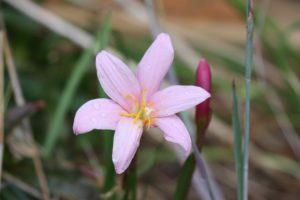

by Lydia Holley August 22, 2022
It is always so exciting to see the rain lilies emerge in late summer. This usually indicates the end of the dry season and the beginning of cooler weather. In my garden, I have white rain lilies and pink rain lilies. The pink ones, Zephyranthes grandiflora, are native to Central America, but do well in East Texas. They are perennial in zones 7 through 10. Thus, they can take our summer heat as well as our cold winters.
Plant rain lily bulbs in spring. Because they are a bulb, they can be planted among other flowers or plants, or in containers if you prefer. Should you grow them in containers, you may need to divide them every few years so they do not get too root bound. You may also wish to plant them in masses, along an edging, or scatter them throughout the garden. No matter where you plant them, they will bring a smile to your face when they begin to bloom.
Rain lilies have various common names including rain flower, zephyr lilies, and fairy lilies. As their name implies, rain lilies usually bloom after a rain. A member of the Amaryllidaceae family, like Amaryllis, rain lilies do well planted in our East Texas soil.
There are numerous species of Zephyranthes. Some are larger than others. If you do not like white or pink, they also come in yellow and rarely, some other colors such as apricot. After you have some planted, you may wish to collect others. I have some pink rain lilies planted by my front door, so I will be certain to see them when they bloom. Their flowers are fleeting, but are worth growing because they are so delightful to see.
For more information, call 903-675-6130, email hendersonCMGA@gmail.com.
Follow us on Facebook: https://www.facebook.com/HCmastergardener.